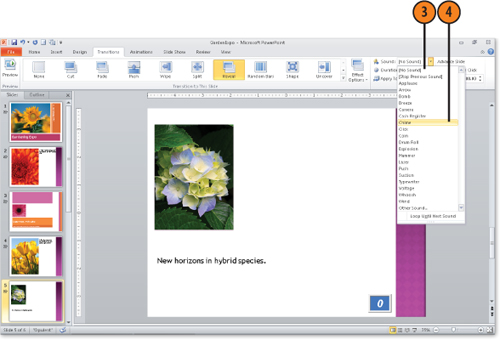1. Adding Sound to a Transition
Imagine
that you have set up a slide transition so that a new slide appears to
fly in from the left side. If you also add a sound effect like a burst
of wind, you can add impact to the transition. That’s what adding sounds
to transitions is all about: catching your audience’s attention with a
sound that complements the transition effect and the contents of the
slide. You can also add sounds to custom animations on individual
objects—so, when that clip art of a pile of money appears, why not have a
cash register sound happen simultaneously?
1.1. Add Sound
Select a slide with a transition applied to it, and click the Transitions tab.
Click the Sound list.

Move your pointer over the sounds in the list to preview them.
Click a sound to apply it to the current slide.

Note:
You can apply a sound to an
object that has a custom animation applied to it simply by selecting the
object before applying the sound.
Note:
If you want a sound to keep
repeating until the next sound is played, click the Loop Until Next
Sound option at the bottom of the Sound list. Repeating a sound in this
way can be a great effect, but don’t let it go on too long, or you’ll
drive your viewers crazy!
2. Modifying Transition Speed
Transitions
can happen at various speeds. Fast transitions between slides provide a
little subconscious shift, but it’s so fast that most people don’t
notice the effect. Transitions that happen slowly, on the other hand,
are more noticeable to viewers, but you run the danger of slowing down
your presentation if you overuse them. The ability to control the speed
of transitions is useful, but you have to determine which speed best
fits each transition and your presentation.
2.1. Set the Speed for Transitions
Display a slide that has a transition applied to it.
Click the Transitions tab if necessary.
Use the spinner arrows on the Duration field to display the transition for a longer or shorter time.

Note:
If you play a sound
along with a transition and you set the transition to run fast, the
sound occurs quickly, too. In fact, the sound may happen so quickly that
it can be hard to tell what the sound is. If you associate a sound like
a typewriter, for example, with a fast transition, your viewers might
hear a single click of a typewriter key—not enough to know what it is
they are hearing!
Note:
To use the transition speed
that is applied to the currently selected slide for all the slides in
your presentation, click the Apply To All button on the Animations tab.